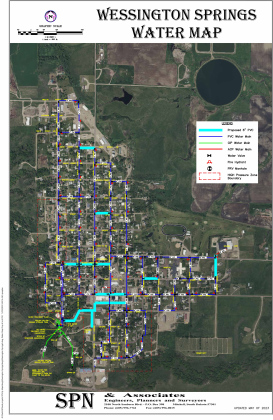“On borrowed time”
While no test results have come back indicating that the water in Wessington Springs is considered unsafe to drink, findings from a comprehensive study of the city’s municipal water system point to a wide array of deficiencies throughout the town’s water source, treatment plant, storage and distribution systems — forcing immediate, emergency repairs while city leadership is forced into making tough decisions when it comes to the future of the municipality’s water.
Camden Hofer alongside Jeff McCormick, both of SPN & Associates Civil Engineers and Land Surveyors presented study findings to city council on Monday, December 4, 2023.
“At any point that plant can have any type of catastrophe that would shut it down. That’s just the condition it is in,” said Hofer. “The operator needs to be commended for keeping it running but we recommend emergency repairs. It’s on borrowed time.”
The presentation covered multiple areas: an evaluation of the existing system including water source, treatment, storage, distribution and meters; emergency improvements; proposed improvements including complete plant renovation as well as the viability of hooking into Mid-Dakota Rural Water.
Having launched the study in October at the request of the city, SPN & Associates evaluated the existing plant by the various government water quality standards required to be met, along with needs that will arise in the future.
“What we’re seeing is a plant that started in 1986 with very few updates made to it. The city can be commended for keeping an old plant like this in operation. It has a typical design life of maybe 20 years so the plant is beyond its useful life expectancy. We need new equipment or a new plant,” Hofer said, adding that the water system is made up of approximately 475 water connections, with two wells and one spring serving as the water sources. “Water treatment consists of a lime-softening plant with sand filtration and liquid chlorine disinfection. Water storage is provided by a clear well at the plant and two ground storage tanks.”
When it comes to water usage, records from 2014 to 2022 were used to determine water demand. The water loss rate was found to be an average of 36 percent in 2023, which according to Hofer is “very high.”
Recommended improvements As for water sources, the study findings recommend demolishing the south spring and constructing a new well.
“There are many gaps and cracks that could contaminate the water in the spring south of the campground. And in the north well, the pipes are rusty and it frequently floods. The piping, valves and fittings are in poor condition at both wells,” Hofer shared.
In the grand scheme of the water system, the water storage requires minimal repair but when it comes to the water plant, the repairs needed are vast, with ten items topping the list and requiring emergency attention: sludge valve with automated control, monitoring system improvements, chemically clean filter sand, add sand to filter, perform jar testing to optimize coagulant, complete chemical pump calibrations, clean lime sludge from holding tank, replace holding tank pump, remove and dispose of lime sludge, improve sampling and reporting.
“The sand is severely coated with solid material and it’s not efficiently filtering anymore. The city has the proposal to clean and add sand” said Hofer.
The city did approve the $19,516.92 sand filtration improvements later at the meeting and also voted to authorize Community Development Specialist Brian McGinnis of District III, who joined the meeting on the phone, to seek out grant and government program funding for the emergency repairs, which were presented to cost between $216,000 and $300,000.
Long term water system improvement options Lastly, the estimated costs of long term water system improvements were presented: Rural Water - $11.8 million with an additional $53,000 annual cost.
New Municipal Water Treatment Plant - $11.3 million with an additional $29,000 annual cost.
“Both of these options are going to take time. The reality of beginning construction for a new plant, you’re looking to 2025 to 2026 and about two years for rural water,” McCormick pointed out.
Add to the complexities of both projects and time investment are the enormous, “once in a lifetime” price tags that will require a significant amount of grant funding through Department of Agriculture and Natural Resources (DANR) paired with other sources.
“We need to see what type of a subsidy we can get,” McGinnis said. “With a January 1 deadline for this type of funding, the town has some tough decisions to make.”
McGinnis suggested scheduling a meeting with city leadership and all the players involved in projects such as these.
“I worked with another town in the exact same dilemma and we did a Zoom with engineers, DANR and city council,” he suggested.
The council agreed that additional meetings and research are necessary and took no further action at last week’s meeting aside from authorizing McGinnis to seek funding for the emergency repairs.
Look to upcoming print and e-editions of the True Dakotan for more details about the City of Wessington Springs’ long term water system plans.



